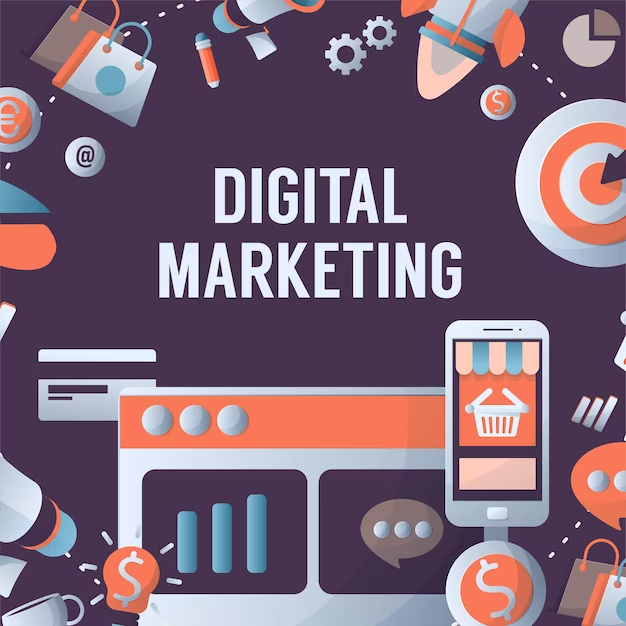With the invention of new technologies,history and evolution of digital marketing continues to evolve. To appreciate modern-day techniques and strategies, you must keep up with the latest developments and understand the history of your field.
We’ll discuss digital marketing’s evolution, predictions for the future, and lessons to keep in mind. Let’s get started!
Digital Marketing: The Current State
In digital marketing, products and services are promoted via the internet. As with traditional marketing, your goal is to create awareness of your brand and products.
Before digital The avenues included billboards, TV and radio ads, newspapers, direct mail, phone calls, postcards, catalogs, brochures, and other print materials.
There are still some traditional marketing tools that are effective even today, when so many companies are scrambling to reach as many customers as possible. Physical copies of newspapers, for instance, may be more comfortable for older segments of a brand’s audience than their digital counterparts. Also, radio marketing isn’t dead.
One of the main differences between the two forms is the reach they provide. You might be able to target local consumers with radio or newspaper ads. If you want to market globally, digital methods are your best choice. Additionally, they can be more cost-effective than traditional methods.
Tweets, videos, podcasts, emails, blog content, and Pay-Per-Click (PPC) advertising can all be used in digital marketing. History And Evolution OF Digital Marketing and It is estimated that 3.5 billion people use social media worldwide, or nearly 45% of the world’s population.
Furthermore, marketing to younger generations is becoming increasingly difficult. To convince them to buy, it can take a lot of convincing. You can reach and sell to them over time with your digital marketing campaigns. In general, digital mediums offer better ways to stay in touch with your audience and build connections.
5 Key Turning Points in Digital Marketing
Having discussed the current state of digital marketing, let’s now examine how it has evolved over time, using examples from some major milestones.
1. The role of search engines
The World Wide Web was launched in 1991, but it didn’t make a huge impact until 1994, when Netscape became the first really popular browser. During the 1990s and early 2000s, as more people began to use the internet, search engines such as Google appeared.
Using keywords in search terms, search engines crawl web pages and store them for later retrieval. SEM (Search Engine Marketing) involves promoting websites and blogs through strategies like Search Engine Optimization (SEO) and paid advertising in order to increase their visibility.
2. Social media revolution
Originally, the World Wide Web was intended to be a collaborative platform for sharing information. It has probably become much more than that. Facebook, Twitter, and many other social media platforms have made it possible to exchange information and connect with others.
Businesses can also reach global audiences this way. Brands can do this by using paid ads targeted at general or specific audiences, or by partnering with influencers who market products to their followers.
In 2004, Facebook, for example, had a million users by the end of the year. A self-service advertising platform and business pages were launched in 2007, further increasing overall ad revenue to $700 million. Platforms have followed suit, providing brands with a platform to reach their customers.
3. A mobile-first marketing strategy
As a result of Google’s Accelerated Mobile Pages (AMP) project, mobile sites need to be SEO-optimized. The initiative aims to improve the loading times of pages on smartphones and tablets. Other factors such as User Experience (UX) are also considered.
Recent statistics regarding mobile usage make this particularly relevant. Mobile phones accounted for 52.2% of all web traffic in 2019, up from 16.2% in 2013. The data here only applies to mobile phones, not tablets.
Mobile usage, as well as the AMP initiative, have made it critical to ensure that marketing campaigns are not only accessible on larger devices, but also viewed smoothly on smaller screens.

4. Targeted campaigns and consumer data
The use of data for creating targeted marketing campaigns is another major milestone in digital marketing history. Data-driven marketing activities enable brands to build long-term relationships with their customers through Customer Relationship Management (CRM).
CRM tools enable you to work iteratively based on performance analytics data. As a result, it is easier to predict customers’ purchasing habits, to define target audiences, and to increase overall customer satisfaction.
Because technology and other factors are constantly changing marketing strategies, it is particularly important to be able to predict customer behavior. Any changes in consumer habits can be identified by using CRM techniques such as regression and statistical analysis.
As a result, marketing performance can be measured more accurately using better business impact models.
5. Interactive content and voice search
Brands must increase engagement with customers and foster a sense of community and loyalty. Games, fun social media contests, immersive app experiences, and more have resulted from this. As a result, audiences are not only attracted but are also maintained over time.
As for voice search, it is now one of the most important marketing trends, providing a new way to conduct searches and promote businesses. As its results are usually extremely relevant at first attempt, it can also attract more traffic.
The Future of Digital Marketing (and Lessons to Learn)
We can make certain predictions about the future of digital marketing based on current trends. Artificial Intelligence (AI) technologies, for example, will likely become more prevalent. Currently, it is used in content creation, product recommendations, and e-commerce transactions.
Chatbots will also be used more frequently for customer engagement. Mastercard uses a Facebook Messenger bot with natural language processing capabilities to respond to customer queries.
Last but not least, we discussed how voice search has soared in popularity, and we expect it to do so in the future as well. To keep up with your audience’s inevitable adoption of new technologies and practices, all aspects of your marketing strategies should be informed by these trends.
Conclusion
Finding your way forward requires knowing where you’ve been. Marketing is no different. The best way to leverage current technologies and practices is to understand the history of digital marketing.
Has learning about the history and evolution of digital marketing helped you better understand current practices?




Leave A Comment